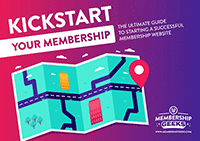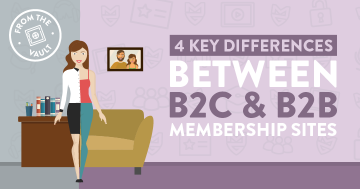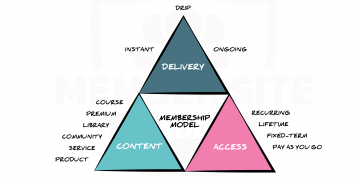Creating a membership website involves a lot more work than most people expect.
Memberships have a lot of moving pieces; not just on the technology front, but also when it comes to strategy, marketing and the day to day logistics too.
It's no surprise then, that so many people get “stuck” when trying to figure out which software to use, what features their site should have and how to implement them, how often to release content, what content to create and so on, and so on… and so on!
When you’re in a situation where you get all up in your head worrying about every little thing, you get nothing done.
We call this “Paralysis by Analysis”
It plagues a lot of people in the planning and building stage of their memberships. Sometimes it can stop you even when you have your membership running and are trying to implement new features.
We see people take months and months to launch their membership site, trying to cram in every idea under the sun. These shiny object ideas have entrepreneurs spiralling out of control!
You’ll never get to where you need to be when you’re piling high a mental load that stops all progress.
Use these 5 strategies to avoid falling prey to decision paralysis.
1. Follow the KISS Principle
Keep. It. Super. Simple.
Think about some of the best experiences you’ve had purchasing something online, using new software, or even booking a holiday. All of these experiences are simple and effortless.
Simplicity makes things great; just think of Apple. One of the big reasons people love everything Apple is how user-friendly it is. The catchphrase of so many Apple fanatics is, “It just works.”
The principle of keeping things simple is the secret to the success of so many websites, products, and services, and is an easy way to avoid analysis paralysis.
Recognize that simplicity is a good thing and that complexity is usually not. If your audience is at different levels of technical capabilities, more features are going to make things more difficult.
Embrace simplicity.
That’s the first step to avoiding paralysis by analysis because once you start striving for simplicity, you recognize that having all the bells and whistles can be a bad thing.

Not these guys…
2. Get Outside Input
If you have a Facebook group, social media followers, existing clients, or a business partner, involve them in discussions. You’ve got to talk this stuff out.
You don’t want to get in a situation where too many cooks ruin the broth so to speak, but you also don’t want to put all the pressure on your shoulders.
What you’ll find is that a simple conversation with your audience or a trusted friend will make you realize that 99% of what you’re worrying about is of little consequence.
Usually things that seem absolutely crucial to you won’t be noticed by other people.
How do you know what people will notice and care about?
You ask them.
Talk to your audience.
Engage in a dialogue and find out the most important things to them.
When you’re looking at a list of features you want, question why you deem something important and see if your audience actually wants it.
3. Set Decision Deadlines
Make a date by which you’ll have a final decision for each area of your membership.
Be strict and tell yourself that you won’t spend any more time on the decision.
Setting deadlines helps you get focused really quick. Instead of being paralyzed, you’ll push yourself to make progress.
There’s nothing wrong with wanting your membership to be perfect, but don’t let that keep you stuck in a decision.
Set milestones and stick to them.
Commit to moving forward without revisiting or constantly rehashing decisions.
4. Embrace Your Limitations
You shouldn’t expect to do everything yourself.
For example, if you’re not a web developer, don’t expect to develop all sorts of custom stuff on your own.
Stick to what you’re good at. If you want to have a website that looks as great as a $10,000-$30,000 designed website, hire someone to do it for you.
If it’s not important enough for you to hire someone to do it, than it’s not important.
Focus on your strengths and accept the fact that you have limitations. Don’t bury yourself in stuff that you shouldn’t be spending your time on.
I’ve actually seen people take a course on how to be a web developer while they’re planning their membership.
They put their membership on hold for 6-12 months while they teach themselves to become a web developer even though the end result still won’t meet their dream expectations.
Unless you’re planning on becoming a professional web developer, you have no business taking a course to teach yourself that stuff to build your membership site.
Accept limitations and move on.
While your membership might not look as polished as a professional web developer’s, you’ll have strengths they don’t have.
5. Understand the Evolution to Avoid Paralysis by Analysis
The membership you launch today will not look the same in 12 months time.
That’s because your members will shape the direction of your membership.
The best ideas and content that your membership will have will come from your members themselves.
The people you’re trying to serve will tell you how they want to be served.
That thing that you spend 20-30 hours fretting over will be the thing nobody cares about. That could be the thing that falls flat!
Memberships are not a finished product.
They’re not static.
You have so much room to grow and evolve.
Remember this as you’re creating your membership to avoid spending too much time on things that don’t matter.





